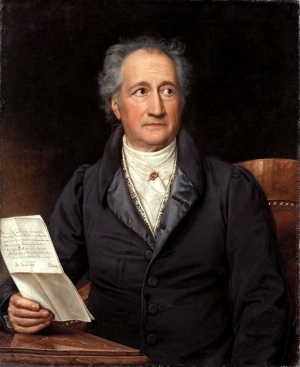Difference between revisions of "Goethe, Johann Wolfgang von (1749-1832)"
| [unchecked revision] | [checked revision] |
GameoAdmin (talk | contribs) (CSV import - 20130820) |
GameoAdmin (talk | contribs) (CSV import - 20130823) |
||
| Line 1: | Line 1: | ||
| − | [[File:Goethe_-Stieler_1828.jpg|300px|thumb|right|''Johann Wolfgang von Goethe | + | [[File:Goethe_-Stieler_1828.jpg|300px|thumb|right|''Johann Wolfgang von Goethe |
in 1828 portrait by Joseph | in 1828 portrait by Joseph | ||
| − | Karl Stieler. Source: [http://en.wikipedia.org/wiki/File:Goethe_(Stieler_1828).jpg | + | Karl Stieler. Source: [http://en.wikipedia.org/wiki/File:Goethe_(Stieler_1828).jpg Wikipedia |
| − | Commons | + | Commons]'']] Johann Wolfgang von Goethe, born 28 August 1749, died 22 March 1832, included some references to Mennonites in his writing and had some personal contact with them. In 1768, while recovering from a serious illness, Goethe wrote a versified letter to Friederike Oeser, describing himself in a series of similes, including the lines |
| − | |||
| − | '']] Johann Wolfgang von Goethe, born 28 August 1749, died 22 March 1832, included some references to Mennonites in his writing and had some personal contact with them. In 1768, while recovering from a serious illness, Goethe wrote a versified letter to Friederike Oeser, describing himself in a series of similes, including the lines | ||
<blockquote> Bald still, wie ein Hypochondrist, | <blockquote> Bald still, wie ein Hypochondrist, | ||
Latest revision as of 14:34, 23 August 2013

Johann Wolfgang von Goethe, born 28 August 1749, died 22 March 1832, included some references to Mennonites in his writing and had some personal contact with them. In 1768, while recovering from a serious illness, Goethe wrote a versified letter to Friederike Oeser, describing himself in a series of similes, including the lines
Bald still, wie ein Hypochondrist,
Und sittig, wie ein Mennonist,
Und folgsam, wei ein gutes Lamm
On his journey up the Rhine in 1774 with Basedow and Lavater the three stopped at two Mennonite homes at Neuwied in the Palatinate, namely, the minister, Lorenz Friedenreich, and the noted clock-maker, Peter Kinzing. Lavater's diary makes interesting comment on the personality of the Mennonites. Goethe had some contact with Mennonites during his service as Minister of Economics in the government of Duke Karl August of Saxe-Weimar, when the latter attempted to establish Mennonite farmers on his land to improve agriculture.
The matter of Goethe and the Mennonites needs further inquiry. For further information on the contacts mentioned, see the items in the Bibliography.
Bibliography
Bach, Adolf, ed. Goethes Rheinreise mit Lavater und Basedow im Sommer 1774. Zurich, 1923: 119.
Correll, Ernst. Das Schweizerische Täufermennonitentum. Tübingen, 1925: 130 f.
Crous, Ernst. "Lavater, Basedow und Goethe bei den Mennoniten in Neuwied." Mennonitische Blätter (1930): 107.
| Author(s) | Elizabeth Horsch Bender |
|---|---|
| Date Published | 1959 |
Cite This Article
MLA style
Bender, Elizabeth Horsch. "Goethe, Johann Wolfgang von (1749-1832)." Global Anabaptist Mennonite Encyclopedia Online. 1959. Web. 14 Apr 2025. https://gameo.org/index.php?title=Goethe,_Johann_Wolfgang_von_(1749-1832)&oldid=94856.
APA style
Bender, Elizabeth Horsch. (1959). Goethe, Johann Wolfgang von (1749-1832). Global Anabaptist Mennonite Encyclopedia Online. Retrieved 14 April 2025, from https://gameo.org/index.php?title=Goethe,_Johann_Wolfgang_von_(1749-1832)&oldid=94856.
Adapted by permission of Herald Press, Harrisonburg, Virginia, from Mennonite Encyclopedia, Vol. 4, p. 1140. All rights reserved.
©1996-2025 by the Global Anabaptist Mennonite Encyclopedia Online. All rights reserved.
